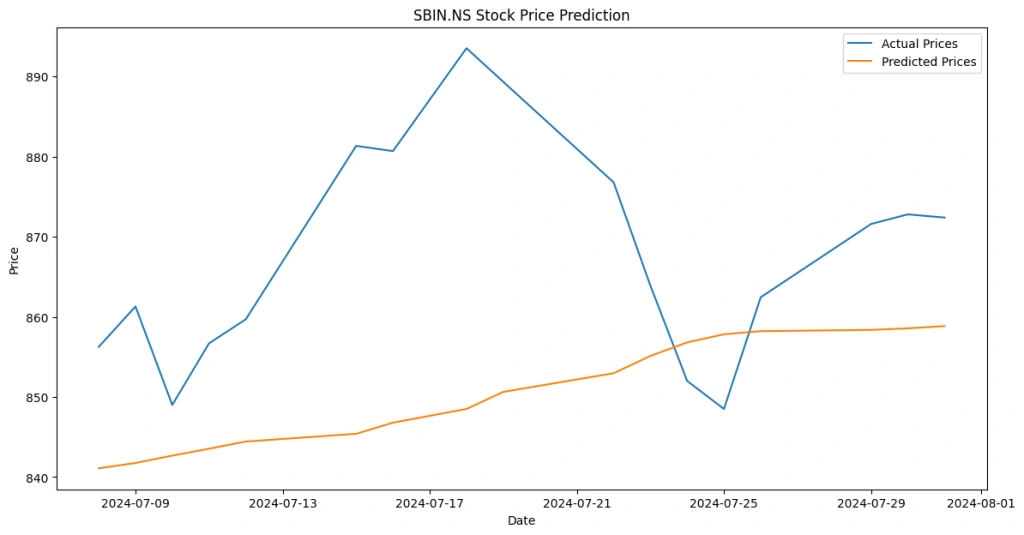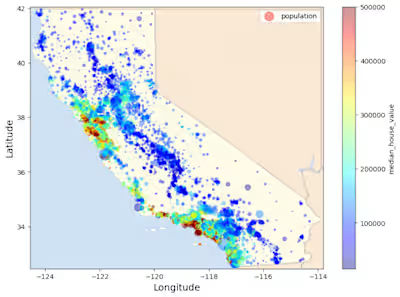Comprehensive Stock Analysis and Prediction Using LSTM: A Case …
Introduction
In the fast-paced world of stock trading, the ability to analyze and predict stock price movements is crucial for making informed investment decisions. This project leverages historical stock data from the National Stock Exchange of India (NSE) to identify undervalued stocks and predict future price trends using advanced machine learning techniques.
The project begins with data acquisition, where I used the Yahoo Finance API to gather daily stock price data for major Indian companies, including Reliance Industries (RELIANCE.NS), Tata Consultancy Services (TCS.NS), Infosys (INFY.NS), HDFC Bank (HDFCBANK.NS), ICICI Bank (ICICIBANK.NS), and State Bank of India (SBIN.NS).I have used 5 companies for showcase it can be easily used for more. The dataset spans the past year, providing a robust foundation for both analysis and forecasting.
1. Undervaluation Screening: We implement a screening process to identify undervalued stocks based on significant downward movements from their 7-day average closing prices. This involves calculating daily price movements and ranking stocks to highlight those with the greatest deviation from their recent average.
2. Data Enrichment: Additional market data, such as market movement, industry movement, and index movement, is integrated into the dataset to provide a more comprehensive view of stock performance relative to broader market trends.
3. Data Filtering: The project applies various filters to refine the list of undervalued stocks. These filters include fundamental strength and popularity criteria, as well as market size rankings to ensure the selection of robust investment opportunities.
4. Visualization: Using Plotly, we create visual representations of the undervalued stocks, including bar charts to display movement percentages and line charts to visualize historical price trends for specific stocks.
5. Prediction Modeling: To forecast future stock prices, we employ Long Short-Term Memory (LSTM) networks, a type of recurrent neural network (RNN) well-suited for time series prediction. This involves training an LSTM model on historical price data and evaluating its performance with a focus on prediction accuracy.
This project not only provides a tool for identifying and analyzing undervalued stocks but also offers insights into future price movements, aiding investors in making data-driven decisions. Through detailed data processing, visualization, and predictive modeling, the project demonstrates a practical approach to stock market analysis and forecasting.
CODE :
import yfinance as yf
import pandas as pd
import numpy as np
from datetime import datetime, timedelta
end_date = datetime.today()
start_date = end_date – timedelta(days=365) # For a year of data
tickers = [
‘RELIANCE.NS’, ‘TCS.NS’, ‘INFY.NS’, ‘HDFCBANK.NS’, ‘ICICIBANK.NS’,’SBIN.NS’
]
def fetch_data(tickers, start_date, end_date):
data = {}
for ticker in tickers:
try:
df = yf.download(ticker, start=start_date, end=end_date, interval=’1d’)
df[‘Ticker’] = ticker
data[ticker] = df
except Exception as e:
print(f”Error fetching data for {ticker}: {e}”)
return data
def calculate_movement(df):
df[‘7day_avg’] = df[‘Close’].rolling(window=7).mean()
df[‘Movement’] = (df[‘Close’] – df[‘7day_avg’]) / df[‘7day_avg’] * 100
return df
def screen_undervalued_stocks(data):
undervalued = []
for ticker, df in data.items():
df = calculate_movement(df)
latest_movement = df.iloc[-1][‘Movement’]
undervalued.append((ticker, latest_movement))
undervalued.sort(key=lambda x: x[1], reverse=True)
return undervalued
def get_stock_data():
data = fetch_data(tickers, start_date, end_date)
undervalued_stocks = screen_undervalued_stocks(data)
return undervalued_stocks
undervalued_stocks = get_stock_data()
df = pd.DataFrame(undervalued_stocks, columns=[‘Ticker’, ‘Movement’])
df = df.sort_values(by=’Movement’, ascending=False)
df.to_csv(‘undervalued_stocks.csv’, index=False)
print(df)
Ticker Movement
0 ICICIBANK.NS 1.822643
1 RELIANCE.NS 0.754712
2 SBIN.NS 0.125430
3 TCS.NS 0.016964
4 INFY.NS 0.003452
5 HDFCBANK.NS -0.140018
def fetch_market_data():
return {
‘Market_Movement’: 1.5,
‘Industry_Movement’: 2.0,
‘Index_Movement’: 0.5
}
def integrate_additional_fields(df):
market_data = fetch_market_data()
df[‘Market_Movement’] = market_data[‘Market_Movement’]
df[‘Industry_Movement’] = market_data[‘Industry_Movement’]
df[‘Index_Movement’] = market_data[‘Index_Movement’]
return df
df = integrate_additional_fields(df)
df.to_csv(‘undervalued_stocks_with_movements.csv’, index=False)
def apply_filters(df):
filtered_df = df[df[‘Movement’] > -5]
return filtered_df
df_filtered = apply_filters(df)
df_filtered.to_csv(‘filtered_undervalued_stocks.csv’, index=False)
import plotly.express as px
import pandas as pd
def plot_undervalued_stocks_plotly(df):
fig = px.bar(df, x=’Ticker’, y=’Movement’,
title=’Undervalued Stocks Based on Movement’,
labels={‘Movement’: ‘Movement (%)’, ‘Ticker’: ‘Stock Ticker’},
color=’Movement’, color_continuous_scale=px.colors.sequential.Inferno)
fig.update_layout(xaxis_title=’Stock Ticker’, yaxis_title=’Movement (%)’, xaxis_tickangle=-45)
fig.show()
df = pd.read_csv(‘undervalued_stocks.csv’)
plot_undervalued_stocks_plotly(df)

After Undervaluation Screening I have used SBIN for simplicity same can be used for others also.
import yfinance as yf
import pandas as pd
import plotly.express as px
def fetch_data_multiple_days(ticker, start_date, end_date, interval=’1d’):
stock = yf.Ticker(ticker)
data = stock.history(start=start_date, end=end_date, interval=interval)
data = data.reset_index()
return data
def plot_stock_data(ticker, start_date, end_date, interval=’1d’):
df = fetch_data_multiple_days(ticker, start_date, end_date, interval)
if df.empty:
print(f”No data available for ticker {ticker} between {start_date} and {end_date}.”)
return
fig = px.line(df, x=’Date’, y=’Close’,
title=f’Stock Prices for {ticker} from {start_date} to {end_date}’,
labels={‘Close’: ‘Price ($)’, ‘Date’: ‘Date’})
fig.update_layout(xaxis_title=’Date’, yaxis_title=’Price ($)’)
fig.show()
plot_stock_data(‘SBIN.NS’, ‘2023-08-10’, ‘2024-08-10′, interval=’1d’)

from sklearn.preprocessing import MinMaxScaler
from sklearn.model_selection import train_test_split
import tensorflow as tf
from tensorflow.keras.models import Sequential
from tensorflow.keras.layers import LSTM, Dense
import matplotlib.pyplot as plt
def fetch_data(ticker, start_date, end_date):
stock = yf.Ticker(ticker)
data = stock.history(start=start_date, end=end_date)
return data
def prepare_data(df, feature_col=’Close’, look_back=60):
data = df[[feature_col]].values
scaler = MinMaxScaler(feature_range=(0, 1))
scaled_data = scaler.fit_transform(data)
X, y = [], []
for i in range(len(scaled_data) – look_back):
X.append(scaled_data[i:i+look_back])
y.append(scaled_data[i+look_back])
X, y = np.array(X), np.array(y)
return X, y, scaler
def build_lstm_model(input_shape):
model = Sequential()
model.add(LSTM(50, return_sequences=True, input_shape=input_shape))
model.add(LSTM(50))
model.add(Dense(1))
model.compile(optimizer=’adam’, loss=’mean_squared_error’)
return model
ticker = ‘SBIN.NS’
start_date = ‘2024-01-01’
data = fetch_data(ticker, start_date, end_date)
X, y, scaler = prepare_data(data)
X_train, X_test, y_train, y_test = train_test_split(X, y, test_size=0.2, shuffle=False)
model = build_lstm_model(input_shape=(X_train.shape[1], X_train.shape[2]))
history = model.fit(X_train, y_train, epochs=20, batch_size=32, validation_split=0.1)
predictions = model.predict(X_test)
predictions = scaler.inverse_transform(predictions)
y_test = scaler.inverse_transform(y_test)
plt.figure(figsize=(14, 7))
plt.plot(data.index[-len(y_test):], y_test, label=’Actual Prices’)
plt.plot(data.index[-len(y_test):], predictions, label=’Predicted Prices’)
plt.xlabel(‘Date’)
plt.ylabel(‘Price’)
plt.title(f'{ticker} Stock Price Prediction’)
plt.legend()
plt.show()

Like this project
Posted Sep 11, 2024
This project leverages historical stock data from the National Stock Exchange of India (NSE) to identify undervalued stocks and predict future price trends.






